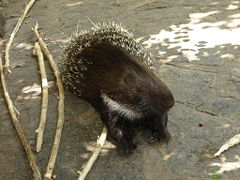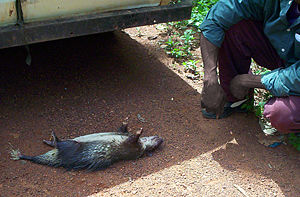Old World porcupine
| Old World porcupines
| ||||||||||||||
|---|---|---|---|---|---|---|---|---|---|---|---|---|---|---|
 Old World porcupine
| ||||||||||||||
| Scientific classification | ||||||||||||||
| ||||||||||||||
|
Atherurus |
Old World porcupine is the common name for any of the large, stocky, terrestrial rodents comprising the family Hystricidae, characterized by short limbs, a tail less than half as long as the head and body, and a spiny covering of sharp quills, spines, and bristles that are not barbed, unlike the barbed quills of the New World porcupines of the Erethizontidae family. Old World porcupines range over the south of Europe, most of Africa, India, and the Malay Archipelago as far east as Borneo.
Although both the Old World and New World porcupine families belong to the Hystricognathi branch of the vast order Rodentia, and share a similar appearance with a large, heavyset body covered by quills, spines, or bristles, these families are quite different and are not closely related.
Overview and description
The common name porcupine is shared by the two taxonomic families of rodents: Hystricidae (Old World porcupines) and Erethizontidae (New World porcupines). Both have heavyset bodies covered with long quills or spines (modified hairs), which can detach easily from the skin when touched and become embedded in a potential predator. The quills or spines take on various forms, depending on the species, but all are modified hairs coated with thick plates of keratin, and are embedded in the skin musculature.
However, despite a similarity in appearance, the two porcupine families are quite different, including the fact that the spines of the Old World porcupines lack the barbules characteristic of the New World porcupines. In addition, the Old World porcupines are usually terrestrial and normally do not climb trees, while the New World porcupines are characteristically arboreal (adapted to life in trees) (Atkins 2004; Mertz 2004).
Old World porcupines are stout, heavily-built animals, with blunt rounded heads, fleshy mobile snouts, and coats of thick cylindrical or flattened spines, which form the whole covering of their body, and are not intermingled with ordinary hairs. They vary in size from the relatively small brush-tailed porcupines with body lengths of 37 to 47 centimeters (15 to 19 inches), and a weight of 1.5 to 3.5 kilograms (3.3 to 7.7 pounds), to the much larger crested porcupines, which are 60 to 83 centimeters (24 to 33 inches) long, discounting the tail, and weigh from 13 to 27 kilograms (29 to 60 pounds) (van Aarde 1984).
Distribution
Behavior, diet, and reproduction
The habits of most species are strictly terrestrial.
The various species are typically herbivorous, eating fruit, roots, and bulbs. Some species also gnaw on dry bones, perhaps as a source of calcium. Like other rodents, they have powerful gnawing incisors, and no canine teeth. Their dental formula is:
| 1.0.1.3 |
| 1.0.1.3 |
One or two (or, rarely, three) young are born after a gestation period of between 90 and 112 days, depending on the species. Females typically give birth only once a year, in a grass-lined underground chamber within a burrow system. The young are born more or less fully developed, and the spines, which are initially soft, harden within a few hours of birth. Although they begin to take solid food within two weeks, they are not fully weaned until 13 to 19 weeks after birth. The young remain with the colony until they reach sexual maturity at around two years of age, and share the burrow system with their parents and siblings from other litters. Males, in particular, help defend the colony from intruders, although both sexes are aggressive towards unrelated porcupines[1].
These rodents are also characterized by the imperfectly rooted cheek-teeth, imperfect clavicles or collar-bones, cleft upper lip, rudimentary first front-toes, smooth soles, six teats arranged on the side of the body, and many cranial characters.
Species
Of the three genera, Hystrix is characterized by the inflated skull, in which the nasal cavity is often considerably larger than the brain-case, and the short tail, tipped with numerous slender-stalked open quills, which make a loud rattling noise whenever the animal moves.
The Crested Porcupine (Hystrix cristata) is a typical representative of the Old World porcupines, and occurs throughout the south of Europe and North and West Africa. It is replaced in South Africa by the Cape Porcupine, H. africaeaustralis, and in India by the Malayan Porcupine (H. leucura).
Besides these large crested species, there are several smaller species without crests in north-east India, and the Malay region from Nepal to Borneo.
The genus Atherurus includes the brush-tailed porcupines which are much smaller animals, with long tails tipped with bundles of flattened spines. Two species are found in the Malay region and one in Central and West Africa. The latter species, the African Brush-tailed Porcupine (Atherurus africanus), is often hunted for its meat.
Trichys, the last genus, contains one species, the Long-tailed Porcupine (Trichys fasciculata) of Borneo. This species is externally very similar to Atherurus, but differing from the members of that genus in many cranial characteristics.
Fossil species are also known from Africa and Eurasia, with one of the oldest being Sivacanthion from the Miocene of Pakistan. However, it was probably not a direct ancestor of modern porcupines[2].
Species list
The following is a complete list of extant species (Woods and Kilpatrick, 2005) and fossil genera (McKenna and Bell, 1997):
- Family Hystricidae
- Hystrix
- Subgenus Acanthion
- Malayan Porcupine (Hystrix brachyura)
- Sunda Porcupine (Hystrix javanica)
- Subgenus Hystrix
- Cape Porcupine (Hystrix africaeaustralis)
- Crested Porcupine (Hystrix cristata)
- Indian Porcupine (Hystrix indica)
- Subgenus Thecurus
- Thick-spined Porcupine (Hystrix crassispinis)
- Indonesian Porcupine (Hystrix pumila)
- Sumatran Porcupine (Hystrix sumatrae)
- Subgenus Acanthion
- †Miohystrix
- †Xenohystrix
- †Sivacanthion
- Atherurus
- African Brush-tailed Porcupine (Atherurus africanus)
- Asiatic Brush-tailed Porcupine (Atherurus macrourus)
- Trichys
- Long-tailed Porcupine (Trichys fasciculata)
- Hystrix
See also
ReferencesISBN links support NWE through referral fees
- Atkins, W. A. 2004. Old World porcupines. Pages 351-364 in B. Grzimek, D. G. Kleiman, V. Geist, and M. C. McDade, Grimek's Animal Life Encyclopedia. Detroit, MI: Thomson/Gale. ISBN 0787657921 (volume), 0787653624 (set).
- Mertz, L. A. 2004. New World porcupines (Erethizontidae). Pages 365 to 375 in B. Grzimek et al., Grzimek's Animal Life Encyclopedia, 2nd ed., vol. 16, mammals V. Detroit, MI: Thomson/Gale. ISBN 0787657921.
- ↑ Cite error: Invalid
<ref>tag; no text was provided for refs namedEoM - ↑ Savage, RJG, & Long, MR (1986). Mammal Evolution: an illustrated guide. New York: Facts on File, 124–125. ISBN 0-8160-1194-X.
- McKenna, Malcolm C., and Bell, Susan K. 1997. Classification of Mammals Above the Species Level. Columbia University Press, New York, 631 pp. ISBN 0-231-11013-8
- Woods, C. A. and C. W. Kilpatrick. 2005. Hystricognathi. Pp 1538-1600 in Mammal Species of the World a Taxonomic and Geographic Reference 3rd ed. D. E. Wilson and D. M. Reeder eds. Smithsonian Institution Press, Washington D.C.
[1].
Macdonald, D. W., ed. 1984. The Encyclopedia of Mammals. New York: Facts on File. ISBN 0871968711.
|
Sciuromorpha: †Allomyidae | Aplodontiidae | †Mylagaulidae | †Reithroparamyidae | Sciuridae | Gliridae |
|
Castorimorpha: †Eutypomyidae | Castoridae | †Rhizospalacidae | †Eomyidae | †Heliscomyidae | †Mojavemyidae | Heteromyidae | Geomyidae |
|
Myomorpha: †Armintomidae | Dipodidae | Zapodidae | †Anomalomyidae | †Simimyidae | Platacanthomyidae | Spalacidae | Calomyscidae | Nesomyidae | Cricetidae | Muridae |
|
Anomaluromorpha: Anomaluridae | †Parapedetidae | Pedetidae |
|
Hystricomorpha: †Tamquammyidae | Ctenodactylidae | Diatomyidae | †Yuomyidae | †Chapattimyidae | †Tsaganomyidae | †"Baluchimyinae" | †Bathyergoididae | Bathyergidae | Hystricidae | †Myophiomyidae | †Diamantomyidae | †Phiomyidae | †Kenyamyidae | Petromuridae | Thryonomyidae | Erethizontidae | Chinchillidae | Dinomyidae | Caviidae | Dasyproctidae | †Eocardiidae | Cuniculidae | Ctenomyidae | Octodontidae | †Neoepiblemidae | Abrocomidae | Echimyidae | Myocastoridae | Capromyidae | †Heptaxodontidae |
|
Prehistoric rodents (incertae sedis): †Eurymylidae | †Cocomyidae | †Alagomyidae | †Ivanantoniidae | †Laredomyidae | †Ischyromyidae | †Theridomyidae | †Protoptychidae | †Zegdoumyidae | †Sciuravidae | †Cylindrodontidae |
|
† indicates extinct taxa |
Credits
New World Encyclopedia writers and editors rewrote and completed the Wikipedia article in accordance with New World Encyclopedia standards. This article abides by terms of the Creative Commons CC-by-sa 3.0 License (CC-by-sa), which may be used and disseminated with proper attribution. Credit is due under the terms of this license that can reference both the New World Encyclopedia contributors and the selfless volunteer contributors of the Wikimedia Foundation. To cite this article click here for a list of acceptable citing formats.The history of earlier contributions by wikipedians is accessible to researchers here:
The history of this article since it was imported to New World Encyclopedia:
Note: Some restrictions may apply to use of individual images which are separately licensed.
- ↑ van Aarde, Rudi (1984). in Macdonald, D.: The Encyclopedia of Mammals. New York: Facts on File, 704–705. ISBN 0-87196-871-1.
